|
Get
all the evaluations for
the August
Release
Subscribe
to Vintage Assessments today
by Clicking
Here
This
not-for-profit website is dedicated to the discerning reader!
Waiter,
there's a ladybug in my
fermentation tank
And
why good wines end up in Vintages sales
©
Michael Vaughan 2002
National Post
Weekly Wine & Spirits Columnist
Saturday,
August 17, 2002
 I
am discussing today’s Vintages sale with a wine fan. He asks: “if
these wines are any good, how did they end up discounted and on sale?”
I reply that “there are some really
good wine buys - it’s not that all these wines are bad. Unfortunately,
some don’t sell because of the way our monopoly marketing system works.
That and certain agents who are totally complacent about moving wines
once they’ve been sold to the LCBO are to blame.” I
am discussing today’s Vintages sale with a wine fan. He asks: “if
these wines are any good, how did they end up discounted and on sale?”
I reply that “there are some really
good wine buys - it’s not that all these wines are bad. Unfortunately,
some don’t sell because of the way our monopoly marketing system works.
That and certain agents who are totally complacent about moving wines
once they’ve been sold to the LCBO are to blame.”
It
works like this. Every month some 150 new products are scheduled for
Vintages release. Late last spring, the single release was split in
two meaning that the number of wines a customer sees under any Catalogue
heading was been cut in half (August was an exception). By changing
the selection more frequently, customers were being forced to frequent
Vintages more often.
It
all boils down to the way wines end up, or in many more instances don’t
end up, on LCBO shelves. The intent is there - try and get the best
wines at the best prices. Unfortunately, good intentions cannot overcome
the constant onslaught of new wines headed for scarce shelf space. Once
a wine appears and sells out; then, to a very large extent, that’s it.
There are few, if any, curtain calls - at least until the sale scene
is set. It’s like snakes and ladders – an arduous climb to the top,
followed by a rapid descent.
While
the folks at LCBO head office may well want to see these “previously released”
wines put back on the shelves (witness their ever increasing number
in recent Calatogues), stores have no incentive to resurrect them. Once
the listing has appeared in the monthly Catalogue, it is off to the
next new releases. This myopia extends to customers who only see the
new lists, never the full list of all the wines for sale.
It
is simply a matter of out of sight, out of mind. In a privately operated
system, there is an incentive to really promote the existing stock –
get it out in front of the customer. The LCBO also fails to capitalize
on the good press. In theatre, for instance, if a local critic raves,
those positive reviews are hustled out in front of potential customers.
At the LCBO, however, we seem to only get those in-house tasting notes
or often out-of-date reviews. Things are done in a reactive, not proactive,
manner.
A
private retailer, by contrast, will focus on selling the stock on hand
and definitely tells the customer what is available. Unfortunately,
at the LCBO it is impossible to get a full product list.
Ironically, the only up–to-date list available consists of the 384 items
in today’s Vintages sale.
Don’t
get me wrong. There are, of course, a number of wines that are not worth
the grapes they are made from. But why wait 10-17 months to get rid
of them? If wines don’t live up to expectations; cut the losses and
move them out quickly while they are still alive!
Another
problem are the agents who represent said products. Part of their responsibility
is to try to create sales for their products. Unfortunately, some agents
feel that once it has been sold to Vintages, it isn’t their problem
anymore. They simply make no effort whatsoever to move the products
sitting in the Vintages warehouse.
Being
a Madeira fan, I wanted to review Pereira
D’Oliveira 1977 Terrantez Reserva
($74.95) when it was released
last October. I had never heard of the Ontario agent and spent a considerable
amount of time tracking her down. In the process, I discovered that
importing seemed to be just a sideline. I politely groveled while asking
if there might be an opportunity to taste it (Vintages had failed to
present it). The agent wasn’t interested; and even the trade commission
didn’t come up with goods. This is a shame. How many of us are prepared
to rush out and invest this kind of money in wine with zero track record.
As a result, more than half of the entire shipment of 50 cases languished
unsold at the LCBO until being put on sale today for $56.20. The full
list of sale items with ratings is on my website below.
Ladybug Revenge?
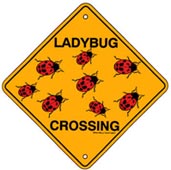 Moving
on, the Ontario wine industry has been all a quake regarding an impending
expose of ladybug “taint.” All of this started after my unabashed squawking
at an Ontario craft wine launch last June. I was decidedly unhappy about
an unsavory tasting East Dell 2001 Unoaked Chardonnay,
which rated 4 out of five ladybugs. Well the good news is that the industry
has finally come clean. Moving
on, the Ontario wine industry has been all a quake regarding an impending
expose of ladybug “taint.” All of this started after my unabashed squawking
at an Ontario craft wine launch last June. I was decidedly unhappy about
an unsavory tasting East Dell 2001 Unoaked Chardonnay,
which rated 4 out of five ladybugs. Well the good news is that the industry
has finally come clean.
You
might graphically remember that 2001 was the year of the aphid. And
who loves aphids? That’s right, ladybugs! And boy did we have ladybugs.
They came in hordes from everywhere; although it is the nasty Asian
ladybug that is credited with the peppery, resiny, bitter, peanut shell
flavours that afflict some Ontario wines. Let me emphasize the word
some, not all or even many – and only in 2001.
What
happened was that the hundreds of millions ravenous ladybugs (who followed
the aphid trail) were lured from their forests habitat and attacked
the ripe grapes. One winemaker recounted to me the flotilla of carcasses
that capped the one of his fermentation tanks. Once squished, the bugs
leave a chemical compound (known as a pyrazine) forms of which naturally
occur in Sauvignon Blanc. While not everyone might detect this taste,
it can overwhelm the natural grape flavours. Obviously when Chardonnay
taste like Sauvignon Blanc, something is amiss.
Unfortunately,
instead of doing the right thing immediately, the industry initially
stumbled around either ignoring or denying. When they got wind that
I was planning an article rating Ontario wines out of five possible
ladybugs, they swung into action. An emergency meeting was held; the
problem acknowledged (although it was trivialized to being a
“fleeting” characteristic); even a number of more contaminated
wines were supposedly taken off the LCBO shelves and returned to the
wineries. It was the kind of action designed to help keep the Q in VQA.
After all, these were VQA approved wines!
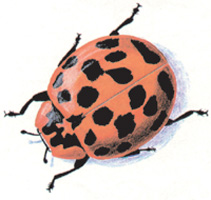 Hopefully,
it is not too little too late. Who knows, some people (they must be
serious Sauvignon Blanc fans) might actually like this ladybug flavour.
As far as I am concerned, if I have a yearning to taste stale peanuts,
I simply head down to Skydome. Hopefully,
it is not too little too late. Who knows, some people (they must be
serious Sauvignon Blanc fans) might actually like this ladybug flavour.
As far as I am concerned, if I have a yearning to taste stale peanuts,
I simply head down to Skydome.
It
might seem ironic that Asian ladybugs (harmonia axyridis) are still
locally available for sale ($160 for 500) Click Here
Prod.
ID: 1052 The Asian lady beetle's bodies are shiny and round either,
red, yellow or orange in color with orange legs and a varying number
of black spots. The larva are black and orange. Feed on hard and soft
scales, such as red pine scales and other soft-bodied insects such as,
aphids, mealybugs, psyllids and whiteflies. Shipped as pre-mated adults.
Somehow sweet, ripe grapes
were not part of their normal menu.
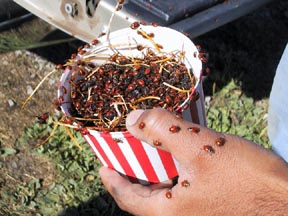 Indeed,
one of Ontario’s better wineries , which has done admirably worked in
an organic direction, has gone so far to put the ladybug (our domestic
variety) on their lable. Their website states: “Malivoire
Sides With Ladybugs” Beamsville,
July 11, 2001 - For the second straight year, the Malivoire Wine Company
has sought the help of thousands of ladybugs to combat the threat of
grapevine and potato leafhopper in its vineyards.
In two releases in a week, Malivoire has scattered over 100,000
ladybugs in one of their vineyards on Niagara’s Beamsville Bench. Last
Thursday’s release also included 5,000 lacewings – another insect predator
that poses no threat to the vines, but will, Malivoire hopes, take a
“bite” out of the leafhopper population.
Leafhoppers damage the leaves of the grape vines and this interferes
with photosynthesis that, in turn, can weaken the whole vine. Indeed,
one of Ontario’s better wineries , which has done admirably worked in
an organic direction, has gone so far to put the ladybug (our domestic
variety) on their lable. Their website states: “Malivoire
Sides With Ladybugs” Beamsville,
July 11, 2001 - For the second straight year, the Malivoire Wine Company
has sought the help of thousands of ladybugs to combat the threat of
grapevine and potato leafhopper in its vineyards.
In two releases in a week, Malivoire has scattered over 100,000
ladybugs in one of their vineyards on Niagara’s Beamsville Bench. Last
Thursday’s release also included 5,000 lacewings – another insect predator
that poses no threat to the vines, but will, Malivoire hopes, take a
“bite” out of the leafhopper population.
Leafhoppers damage the leaves of the grape vines and this interferes
with photosynthesis that, in turn, can weaken the whole vine.
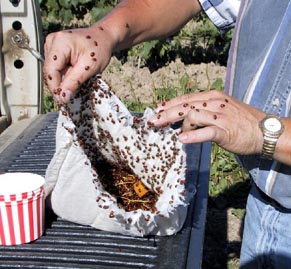 The
ladybugs, or Hippodamia convergens, and lacewings were purchased from
Natural Insect Control, of Stevensville.
The ladybugs come in a one-gallon sack that contains approximately
72,000 adult insects. Packed in wood shavings, the vineyard staff distributed
the ladybugs by taking a handful of shavings and insects, and walking
down the rows of vines shaking a few ladybugs onto each plant. “The
ladybugs won’t fly away as long as they can find something to eat,”
explains vineyard manager Darryl Fields. The
ladybugs, or Hippodamia convergens, and lacewings were purchased from
Natural Insect Control, of Stevensville.
The ladybugs come in a one-gallon sack that contains approximately
72,000 adult insects. Packed in wood shavings, the vineyard staff distributed
the ladybugs by taking a handful of shavings and insects, and walking
down the rows of vines shaking a few ladybugs onto each plant. “The
ladybugs won’t fly away as long as they can find something to eat,”
explains vineyard manager Darryl Fields.
Before
humming a poetically deviant “ladybug,
ladybug, fly away home…” I want to express my heartfelt condolences
to those who see this small creature as a symbol of organic purity.
For some winemakers in 2001, it has been a situation of being “bad to
the last drop.” Something I will have to keep in mind while speaking
at next Wednesday’s organic wine tasting workshop at the 7th International
Congress on Viticulture and Wine in Victoria, BC. To see their programme
Click
Here
Closer
to home, if you want to taste the good side of the organic equation
don’t miss the 14th Annual Feast of Fields
Sunday, September 8, 2002. It stars 40 Ontario chefs, some two dozen
wineries and microbreweries along with some 30 organic farmers. Tickets
are $100. Call (905) 859-3609 (only $90 for Vintage Assessment subscribers).
To get details Click Here
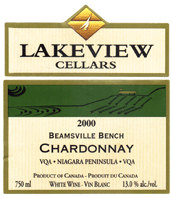 Finally,
the FBTI
wine
of the week
is an unbelievable buy
at only $9.95 on the general list. Lakeview
Cellars 2000 Beamsville Bench Chardonnay
(CSPC: 307165). It
is the best of all 17 wines in the recently launched Ontario Craft program!
The nose is faintly smoky, rather toasty and complex with ripe pear
fruit. It’s rounded and creamy on the palate with caramel, Anjou pear
and lemon meringue pie flavours. Delicious and ready to drink, it is
a definite crowd pleaser and would excel with chicken and white meats.
A big tip of the glass to winemaker Eddy Gurinskas, Tom Green and the
entire Lakeview team. Call the LCBO INFOLINE at 416-365-5900 to find
the store nearest you. Finally,
the FBTI
wine
of the week
is an unbelievable buy
at only $9.95 on the general list. Lakeview
Cellars 2000 Beamsville Bench Chardonnay
(CSPC: 307165). It
is the best of all 17 wines in the recently launched Ontario Craft program!
The nose is faintly smoky, rather toasty and complex with ripe pear
fruit. It’s rounded and creamy on the palate with caramel, Anjou pear
and lemon meringue pie flavours. Delicious and ready to drink, it is
a definite crowd pleaser and would excel with chicken and white meats.
A big tip of the glass to winemaker Eddy Gurinskas, Tom Green and the
entire Lakeview team. Call the LCBO INFOLINE at 416-365-5900 to find
the store nearest you.
“Up Yours” Ottawa ~ A Monopoly Gone Mad?
Unfortunately,
when I examined the list of 57 stores where these 17 Ontario “Craft
wines” are available, I discovered that all
my friends in the nation’s capital were left off the list! Despite
the collective silent groan of the Wine Council of Ontario, the LCBO
insisted on excluding all its Ottawa customers! Why? Because
the LCBO didn’t want the extra expense of putting some stock into the
regional warehouse. Moreover, it is incredible that apparently not
a single LCBO store manager east of Kingston can even order these wines
for their customers. All non-craft store orders have been blocked by
head office. An extremely sad commentary on how the LCBO views its “shareholders.”
As
for pricing, be aware that at this $9.95 LCBO price, Lakeview
Cellars actually looses money on every bottle sold! It receives
approximately $4.02 per bottle vs. $7.54 if it sold the same wine from
its own store. Worse yet, this
wine was to be priced at $11.95 and was submitted at the lower price
only because of extreme anxiety that it would probably not be accepted
by the LCBO if priced over $10. Lakeview bit the bullet and opted to
subsidize its sales in order to introduce wine lovers to its products.
And yet, these are the same LCBO head office executives who are now
denying sales not only to the citizens of Ottawa, but also to every
customer who doesn’t live near one of the 57 stores on the Ontario craft
wine list! “Shame”
is the only word that comes to mind.
Now available
The
list of 384 products being featured in today’s August
17th Vintages Sale
This PDF file (usually reserved for Vintage Assessment subscribers)
is complete with evaluations, agents and cases in warehouse (as per
our July report). Naturally, we hope that you decide to become a supporter.
There are more than a dozen best buys and many recommended items. To
see Click
Here
Subscribe
to Vintage Assessments Today
• Click
Here
|

 I
am discussing today’s Vintages sale with a wine fan. He asks: “if
these wines are any good, how did they end up discounted and on sale?”
I reply that “there are some really
good wine buys - it’s not that all these wines are bad. Unfortunately,
some don’t sell because of the way our monopoly marketing system works.
That and certain agents who are totally complacent about moving wines
once they’ve been sold to the LCBO are to blame.”
I
am discussing today’s Vintages sale with a wine fan. He asks: “if
these wines are any good, how did they end up discounted and on sale?”
I reply that “there are some really
good wine buys - it’s not that all these wines are bad. Unfortunately,
some don’t sell because of the way our monopoly marketing system works.
That and certain agents who are totally complacent about moving wines
once they’ve been sold to the LCBO are to blame.” Moving
on, the Ontario wine industry has been all a quake regarding an impending
expose of ladybug “taint.” All of this started after my unabashed squawking
at an Ontario craft wine launch last June. I was decidedly unhappy about
an unsavory tasting
Moving
on, the Ontario wine industry has been all a quake regarding an impending
expose of ladybug “taint.” All of this started after my unabashed squawking
at an Ontario craft wine launch last June. I was decidedly unhappy about
an unsavory tasting  Hopefully,
it is not too little too late. Who knows, some people (they must be
serious Sauvignon Blanc fans) might actually like this ladybug flavour.
As far as I am concerned, if I have a yearning to taste stale peanuts,
I simply head down to Skydome.
Hopefully,
it is not too little too late. Who knows, some people (they must be
serious Sauvignon Blanc fans) might actually like this ladybug flavour.
As far as I am concerned, if I have a yearning to taste stale peanuts,
I simply head down to Skydome. Indeed,
one of Ontario’s better wineries , which has done admirably worked in
an organic direction, has gone so far to put the ladybug (our domestic
variety) on their lable. Their website states:
Indeed,
one of Ontario’s better wineries , which has done admirably worked in
an organic direction, has gone so far to put the ladybug (our domestic
variety) on their lable. Their website states: 
 Finally,
the
Finally,
the